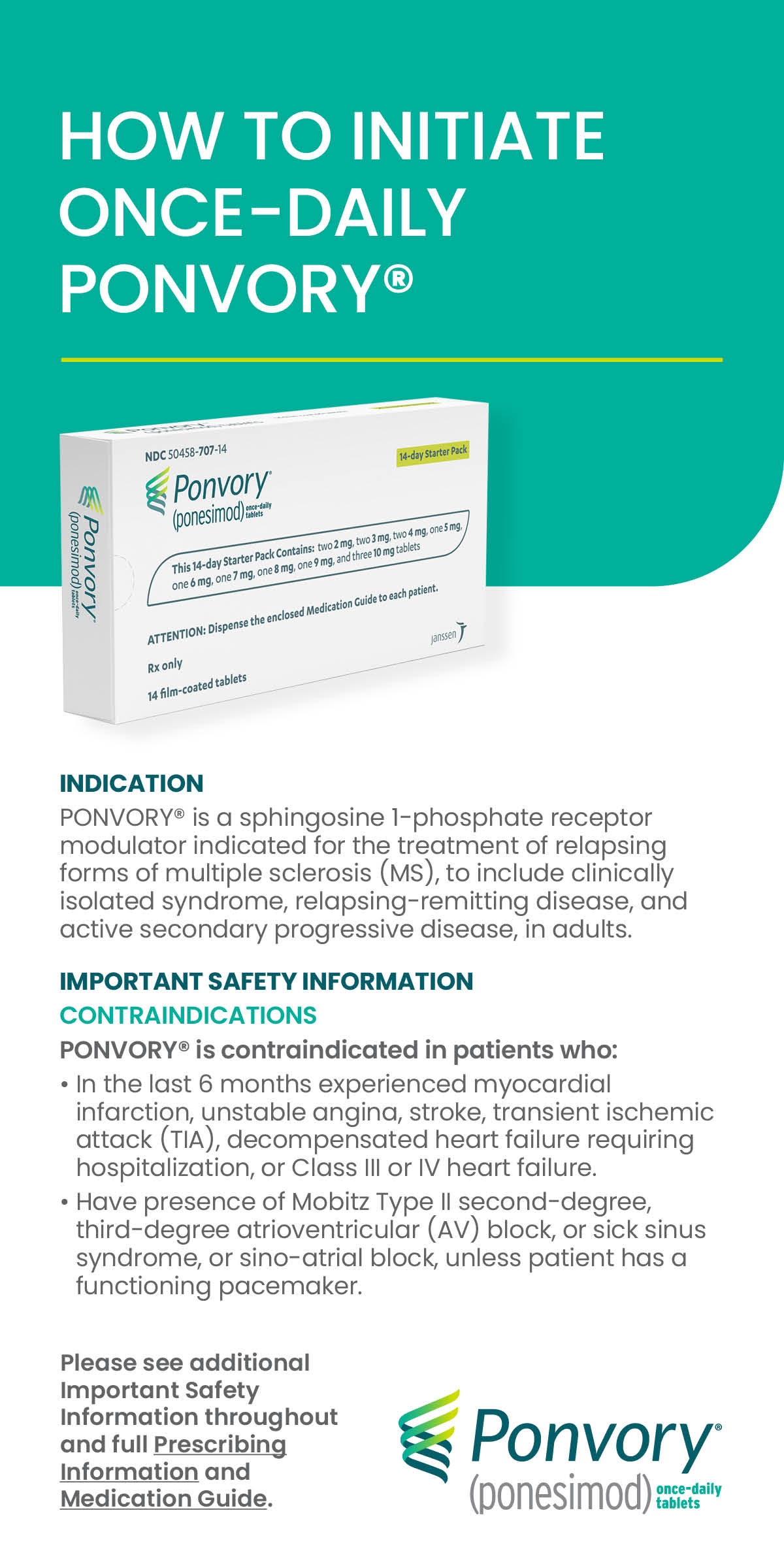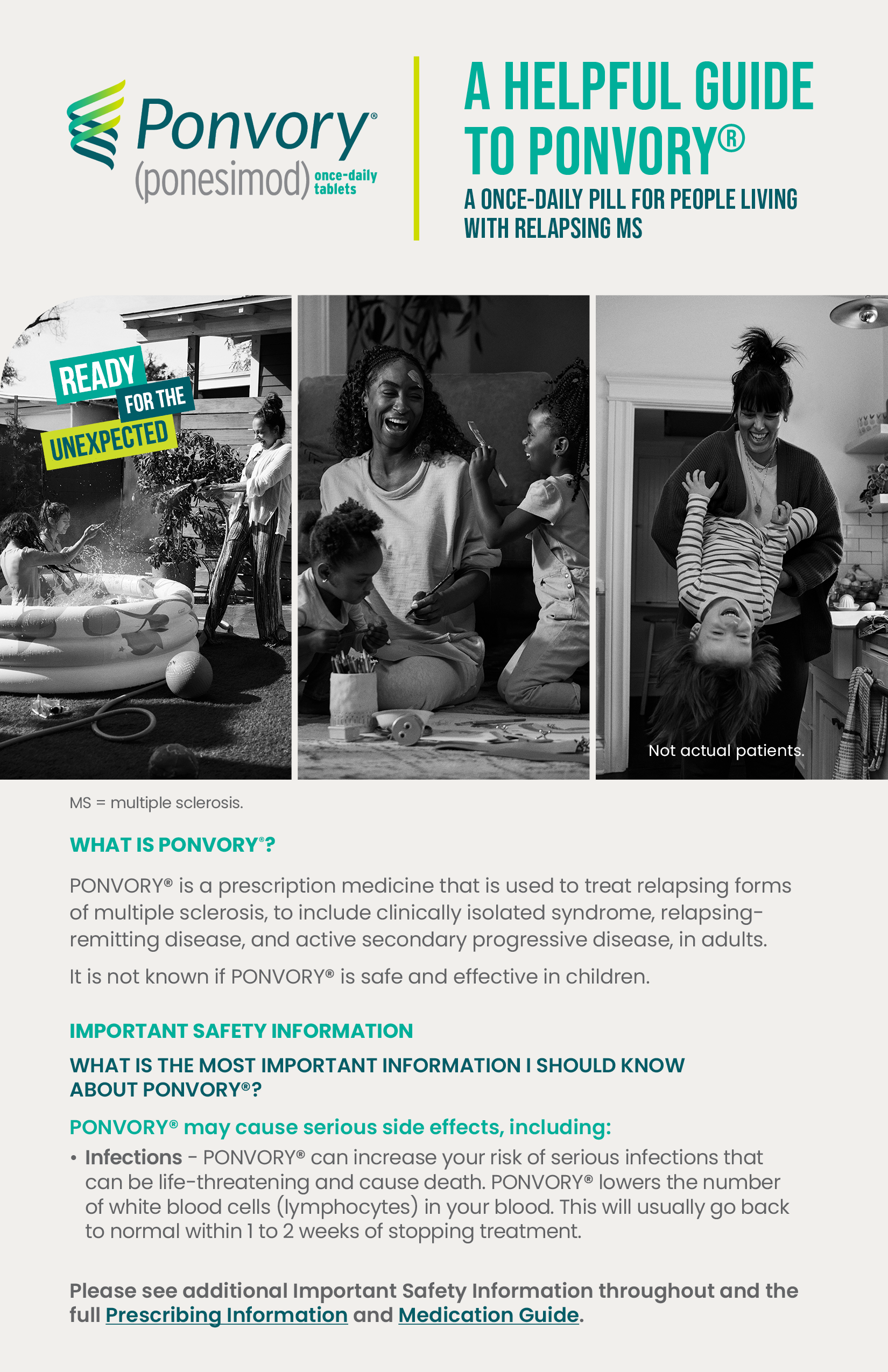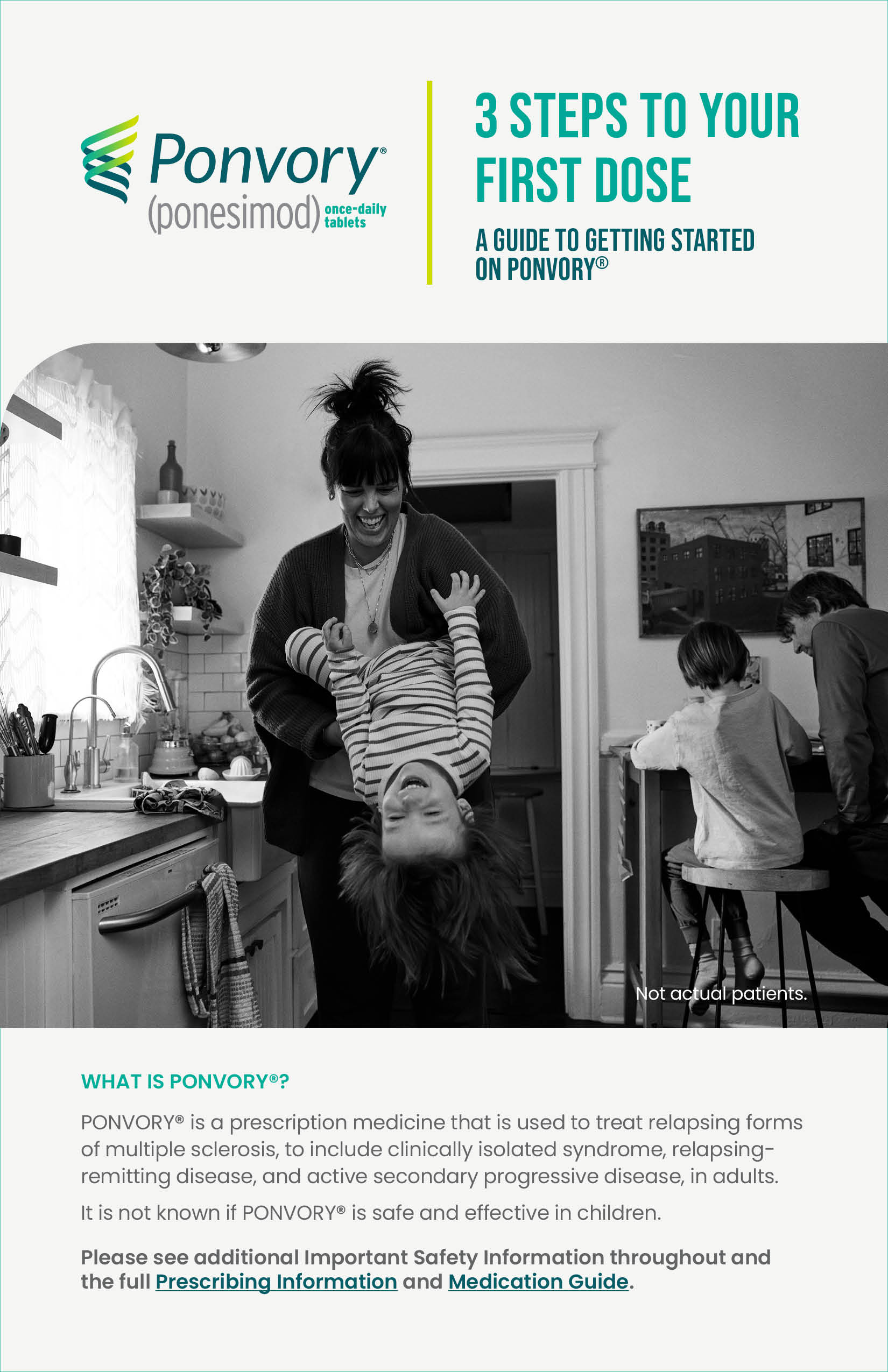CONTRAINDICATIONS
PONVORY® is contraindicated in patients who:
- In the last 6 months experienced myocardial infarction, unstable angina, stroke, transient ischemic attack (TIA), decompensated heart failure requiring hospitalization, or Class III or IV heart failure.
- Have presence of Mobitz Type II second-degree, third-degree atrioventricular (AV) block, or sick sinus syndrome, or sino-atrial block, unless patient has a functioning pacemaker.
WARNINGS AND PRECAUTIONS
Risk of Infections
PONVORY® causes a dose-dependent reduction in peripheral lymphocyte count to 30-40% of baseline values because of reversible sequestration of lymphocytes in lymphoid tissues. PONVORY® may increase the susceptibility to infections. Life-threatening and rare fatal infections have been reported in association with other sphingosine 1-phosphate (S1P) receptor modulators. Before initiating treatment with PONVORY®, results from a recent complete blood count including lymphocyte count should be reviewed. Monitor for infection during treatment and for 1-2 weeks after discontinuation. Do not start PONVORY® in patients with active infection.
Herpes Viral Infections
Cases of herpes viral infection have been reported in the development program of PONVORY®; herpes simplex encephalitis and varicella zoster meningitis have been reported with other S1P receptor modulators. Patients without a healthcare professional confirmed history of varicella (chickenpox) or without documentation of a full course of vaccination should be tested for antibodies to VZV prior to initiating PONVORY®.
Cryptococcal Infections
Cases of fatal cryptococcal meningitis (CM) and disseminated cryptococcal infections have been reported with other S1P receptor modulators. Physicians should be vigilant for clinical symptoms or signs of CM. Patients with symptoms or signs consistent with a cryptococcal infection should undergo prompt diagnostic evaluation and treatment. PONVORY® treatment should be suspended until a cryptococcal infection has been excluded. If CM is diagnosed, appropriate treatment should be initiated.
Progressive Multifocal Leukoencephalopathy (PML)
PML has been reported in patients treated with a S1P receptor modulator and other multiple sclerosis (MS) therapies and has been associated with some risk factors (e.g., immunocompromised patients, polytherapy with immunosuppressants). Longer treatment duration increases the risk of PML in patients treated with S1P receptor modulators with the majority of cases occurring in patients treated for at least 18 months. Physicians should be vigilant for clinical symptoms or magnetic resonance imaging (MRI) findings that may be suggestive of PML. MRI findings may be apparent before clinical signs or symptoms. If PML is suspected, treatment with PONVORY® should be suspended until PML has been excluded.
If PML is confirmed, treatment with PONVORY® should be discontinued.
Immune reconstitution inflammatory syndrome (IRIS) has been reported in patients treated with S1P receptor modulators who developed PML and subsequently discontinued treatment. IRIS presents as a clinical decline in the patient’s condition that may be rapid, can lead to serious neurological complications or death, and is often associated with characteristic changes on MRI. The time to onset of IRIS in patients with PML was generally within a few months after S1P receptor modulator discontinuation. Monitoring for development of IRIS and appropriate treatment of the associated inflammation should be undertaken.
Prior and Concomitant Treatment with Anti-neoplastic, Immune-Modulating, or Immunosuppressive Therapies
Anti-neoplastic, immune-modulating, or immunosuppressive therapies (including corticosteroids) should be co-administered with caution because of the risk of additive immune system effects.
Vaccinations
Patients without a confirmed history of chickenpox or without documentation of a full course of vaccination against VZV should be tested for antibodies to VZV before initiating PONVORY® treatment. A full course of vaccination for antibody-negative patients with varicella vaccine is recommended prior to commencing treatment with PONVORY®, following which initiation of treatment should be postponed for 4 weeks to allow the full effect of vaccination to occur.
No clinical data are available on the efficacy and safety of vaccinations in patients taking PONVORY®. Vaccinations may be less effective if administered during PONVORY® treatment. If live attenuated vaccines are required, administer at least 1 month prior to initiation of PONVORY®. Avoid the use of live attenuated vaccines during and for 1 to 2 weeks after treatment of PONVORY®.
Bradyarrhythmia and Atrioventricular Conduction Delays
Since initiation of PONVORY® treatment results in a transient decrease in heart rate and atrioventricular (AV) conduction delays, an up-titration scheme must be used to reach the maintenance dosage of PONVORY® (20 mg).
Reduction in Heart Rate
Initiation of PONVORY® may result in a transient decrease in heart rate. After the first titration dose of PONVORY®, the decrease in heart rate typically begins within an hour and reaches its nadir within 2-4 hours. The heart rate typically recovers to baseline levels 4-5 hours after administration.
Atrioventricular Conduction Delays
Initiation of PONVORY® treatment has been associated with transient atrioventricular conduction delays that follow a similar temporal pattern as the observed decrease in heart rate during dose titration. If treatment with PONVORY® is considered, advice from a cardiologist should be sought for individuals:
- With significant QT prolongation (QTc greater than 500 msec).
- With atrial flutter/fibrillation or arrhythmia treated with Class Ia or Class III anti-arrhythmic drugs.
- With unstable ischemic heart disease, cardiac decompensated failure occurring more than 6 months prior to treatment initiation, history of cardiac arrest, cerebrovascular disease (TIA, stroke occurring more than 6 months prior to treatment initiation), or uncontrolled hypertension.
- With a history of Mobitz Type II second degree AV block or higher-grade AV block, sick-sinus syndrome, or sino-atrial heart block.
Obtain an ECG in all patients to determine whether preexisting conduction abnormalities are present. For patients taking other drugs that decrease heart rate, treatment with PONVORY® should generally not be initiated without consultation from a cardiologist because of the potential effect on heart rate. In all patients, a dose titration is recommended for initiation of PONVORY® treatment to help reduce cardiac effects.
Respiratory Effects
Dose-dependent reductions in forced expiratory volume over 1 second (FEV1) and reductions in diffusion lung capacity for carbon monoxide (DLCO) were observed in PONVORY®-treated patients mostly occurring in the first month after treatment initiation. Spirometric evaluation of respiratory function should be performed during therapy with PONVORY® if clinically indicated.
Liver Injury
Elevations of transaminases may occur in PONVORY®-treated patients. Obtain transaminase and bilirubin levels, if not recently available (i.e., within last 6 months) before initiation of PONVORY® therapy.
Patients who develop symptoms suggestive of hepatic dysfunction, such as unexplained nausea, vomiting, abdominal pain, fatigue, anorexia, rash with eosinophilia, or jaundice and/or dark urine during treatment, should have hepatic enzymes checked. PONVORY® should be discontinued if significant liver injury is confirmed.
No dosage adjustment is necessary in patients with mild hepatic impairment (Child-Pugh class A). PONVORY® is not recommended in patients with moderate or severe hepatic impairment (Child-Pugh class B and C, respectively).
Increased Blood Pressure
PONVORY®treated patients had an average increase of 2.9 mmHg in systolic blood pressure and 2.8 mmHg in diastolic blood pressure. Blood pressure should be monitored during treatment with PONVORY® and managed appropriately.
Cutaneous Malignancies
The risk of cutaneous malignancies (including basal cell carcinoma (BCC), squamous cell carcinoma, and melanoma) is increased in patients treated with S1P receptor modulators. PONVORY®. may increase the risk of BCC. Skin examinations are recommended prior to or shortly after the start of treatment and periodically thereafter for all patients, particularly those with risk factors for skin cancer. Providers and patients are advised to monitor for suspicious skin lesions. If a suspicious skin lesion is observed, it should be promptly evaluated. As usual for patients with increased risk for skin cancer, exposure to sunlight and ultraviolet light should be limited by wearing protective clothing and using sunscreen with a high protection factor. Concomitant phototherapy with UV-B radiation or PUVA-photochemotherapy is not recommended in patients taking PONVORY®.
Fetal Risk
Based on animal studies, PONVORY® may cause fetal harm. Because it takes approximately 1 week to eliminate PONVORY® from the body, women of childbearing potential should use effective contraception to avoid pregnancy during and for 1 week after stopping PONVORY® treatment.
Macular Edema
S1P receptor modulators, including PONVORY®, have been associated with an increased risk of macular edema. Conduct an ophthalmic evaluation of the fundus, including the macula, in all patients near the start of treatment, periodically while on therapy, and again at any time if a patient reports any change in vision while on PONVORY® therapy. Continuation of therapy in patients with macular edema has not been evaluated. Macular edema over an extended period of time (i.e., 6 months) can lead to permanent visual loss. Consider discontinuing PONVORY if macular edema develops.
Macular Edema in Patients with a History of Uveitis or Diabetes Mellitus
Patients with a history of uveitis and patients with diabetes mellitus are at increased risk of macular edema during therapy with S1P receptor modulators, including PONVORY®. Therefore, these patients should have regular follow-up examinations of the fundus, including the macula, during treatment with PONVORY®.
Posterior Reversible Encephalopathy Syndrome
Rare cases of posterior reversible encephalopathy syndrome (PRES) have been reported in patients receiving a sphingosine 1-phosphate (S1P) receptor modulator. Such events have not been reported for PONVORY®-treated patients in the development program. However, should a PONVORY®-treated patient develop any unexpected neurological or psychiatric symptoms/signs (e.g., cognitive deficits, behavioral changes, cortical visual disturbances, or any other neurological cortical symptoms/signs), any symptom/sign suggestive of an increase of intracranial pressure, or accelerated neurological deterioration, the physician should promptly schedule a complete physical and neurological examination and should consider an MRI. Symptoms of PRES are usually reversible but may evolve into ischemic stroke or cerebral hemorrhage. Delay in diagnosis and treatment may lead to permanent neurological sequelae. If PRES is suspected, PONVORY® should be discontinued.
Unintended Additive Immunosuppressive Effects from Prior Treatment with Immunosuppressive or Immune-Modulating Therapies
When switching from drugs with prolonged immune effects, the half-life and mode of action of these drugs must be considered in order to avoid unintended additive effects on the immune system while at the same time minimizing risk of disease reactivation, when initiating PONVORY®. Initiating treatment with PONVORY® after treatment with alemtuzumab is not recommended.
Severe Increase in Disability After Stopping PONVORY®
Severe exacerbation of disease, including disease rebound, has been rarely reported after discontinuation of a S1P receptor modulator. The possibility of severe exacerbation of disease should be considered after stopping PONVORY® treatment. Patients should be observed for a severe increase in disability upon PONVORY® discontinuation and appropriate treatment should be instituted, as required.
After stopping PONVORY® in the setting of PML, monitor for development of immune reconstitution inflammatory syndrome (PML-IRIS).
Immune System Effects After Stopping PONVORY®
After stopping PONVORY® therapy, ponesimod remains in the blood for up to 1 week.
Starting other therapies during this interval will result in concomitant exposure to ponesimod. Lymphocyte counts returned to the normal range in 90% of patients within 1 week of stopping therapy, however, residual pharmacodynamics effects, such as lowering effects on peripheral lymphocyte count, may persist for 1 to 2 weeks after the last dose. Use of immunosuppressants within this period may lead to an additive effect on the immune system, and therefore caution should be applied 1 to 2 weeks after the last dose of PONVORY®.
OVERDOSAGE
In patients with overdosage of PONVORY®, especially upon initiation/re-initiation of treatment, it is important to observe for signs and symptoms of bradycardia as well as AV conduction blocks, which may include overnight monitoring. Regular measurements of pulse rate and blood pressure are required, and ECGs should be performed.
There is no specific antidote to ponesimod. Neither dialysis nor plasma exchange would result in meaningful removal of ponesimod from the body. The decrease in heart rate induced by PONVORY® can be reversed by atropine.
In the event of overdose, PONVORY® should be discontinued, and general supportive treatment given until clinical toxicity has been diminished or resolved. It is advisable to contact a poison control center to obtain the latest recommendations for the management of an overdose.
ADVERSE REACTIONS
Most common adverse reactions (incidence at least 10%) are upper respiratory tract infection, hepatic transaminase elevation, and hypertension.
Please see full Prescribing Information and Medication Guide.
PON0053V3 08/24



